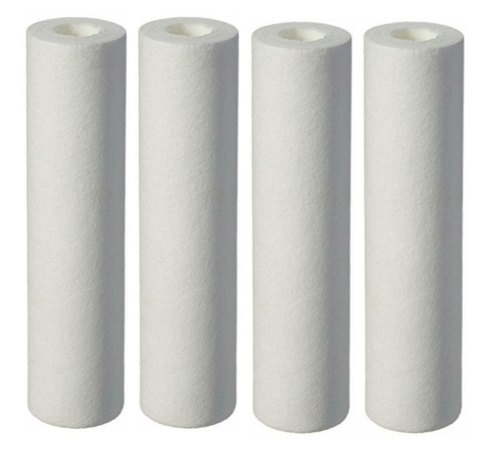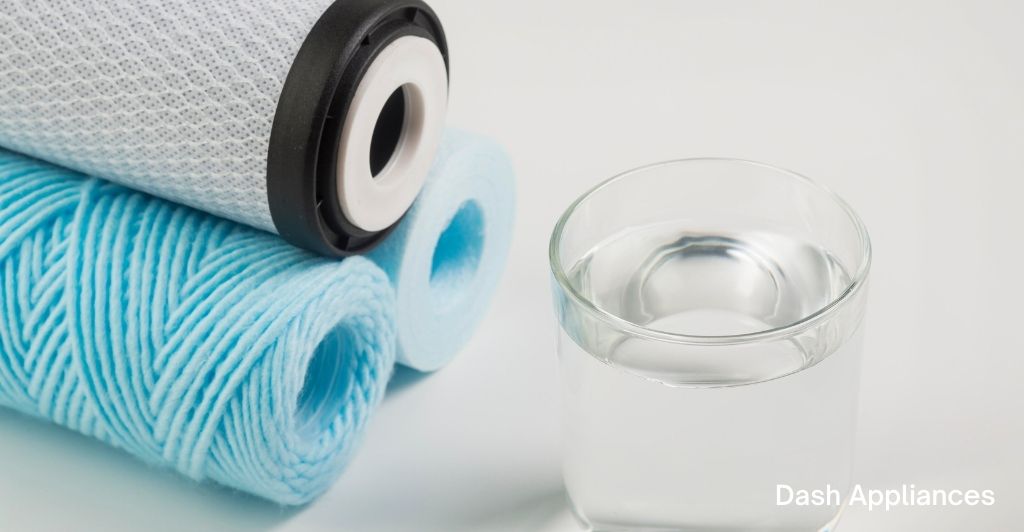To guarantee that you filter out the tiniest of water contaminants, you must make sure that the micron size of the water filter you are using is adequate. It is highly recommended that you choose a micron level of at least 1 or less than that to ensure the total cleanliness of your water.
In this article, we will enlighten you about what a 0.5 micron water filter removes and much more!
Micron and Micron Size
First, let’s learn about what a micron and micron water filter is.
Micron is the unit that is used to measure the size of the pollutants present in the water. It is practically one-millionth of 1 meter or in simple words, it means 1 micrometer.
| Material | Micron Size (approx) |
| Beach Sand | 0.3 to 60 |
| Corn Starch | 0.1 to 0.8 |
| Dust Mites | 100 to 300 |
| Smoke (wood) | 0.2 to 3 |
| Sugar (powdered) | 60 |
| Pet Dander | 0.5 to 100 |
| Coffee (ground) | 5 to 400 |
A micron rating/level is the approximate size of the pollutant that a particular water filter can work to remove. These micron ratings typically range from 0.5 to 5 microns.
Micron Filter
A micron water filter discards waste, dirt, and even some of the tiniest elements from the water. ‘Micron’ is the unit to measure the size of the pores in the water filter cartridge. The lesser the micron level will be, the smaller the matter it will remove. The size of your micron water filter depends on what amount of the tiniest components you wish for your water filter to remove.
For instance, 5-micron water filters discard components down to the size of 5 microns. Any tinier particle will pass from the pores. As most of you would know, sediment water filters are one of the most popular kinds of micron filters today. These filters are just the same as screen entrances that let air in while keeping the flies out. However, the waste that is barred by this water filter is too tiny or microscopic.
‘Class’ in Filters
You may have noticed that water filters usually come with class ratings. The base of this rating is the effectiveness of the water filter as well as the size of the micron.
All the classes are mentioned below along with their specific micron sizes.
- Class I – Ranging from 0.5 to less than 1 micron
- Class II – Ranging from 1 to less than 5 microns
- Class III – Ranging from 5 to less than 15 microns
- Class IV – Ranging from 15 to less than 30 microns
- Class V – Ranging from 30 to less than 50 microns
- Class VI – Greater than 50 microns
What does 0.5 Micron Water Filter Remove?
While water passes through the water filter in your house, you must be of utmost confidence that you will be pouring healthy and pure water into the glass.
If you are using a trusted water filter in your house, you should not be worried about any kind of water pollutants including bacteria and chemicals entering your body. And that comes down to the size of the micron.

Talking about a 0.5-micron water filter, it truly removes a lot.
It can:
- Remove sediment along with other components present in the water
- Lessen the amount of chlorine as well as many other organic chemicals
- Discard parasitic cysts which includes giardia as well as cryptosporidium
- Lessen the amount of lead to a great extent as well as some other heavy metals.
Other Micron Ratings
- 5-micron water filter: A 5-micron water filter will discard the majority of the components that you can easily see for yourself.
- 1-micron water filter: A 1-micron water filter will discard all those components that are too tiny to notice without the help of a microscope.
Is a 0.5-Micron Water Filter Worth Buying?
There are plenty of choices available in terms of micron ratings and one is likely to get confused seeing all the options. If that’s the case, what you first need to determine is your requirement. You will need to understand what exactly you wish to filter out of your water.
Parasitic cysts are one of the most common contaminants found in the majority of the water supplies and they are also very hazardous. Although in many regions, it is ensured that the water supplies do not contain cysts, they may still enter the water supply along with other bacteria. Therefore, on paper, it is recommended that one must choose a micron rating of 1 or less to ensure maximum cyst removal.
However, It is worth mentioning that the water filter with 1 micron will certainly filter out all the parasites but not necessarily all the bacteria. The majority of the bacteria have a size of 0.4 to 2 microns. Any bacteria less than one micron will not be removed using the one-micron water filters and therefore, in this situation, a 0.5-micron water filter is far more suitable.
Although it may cost you slightly more, it will certainly be worth it as you would not want to compromise on the quality of water that you drink.
Conclusion
That was all about Micron, micron water filters, and working of 0.5-micron filters. As you would already know by now, the lesser the micron level, the greater the number of pollutants it will remove. However, it is important to mention that loss in the flow rate is likely with small-sized micron levels. To keep the flow in check, you can get a bigger pump so that you filter out the smallest contaminants while ensuring lesser or no loss in the flow rate.
Frequently Asked Questions (FAQs)
How do I choose the appropriate micron rating?
The primary step while choosing your micron rating is understanding what is present in the water and what needs to be filtered. It is worth noting how essential removing all the water pollutants is. After this, see whether a nominal or an absolute micron filter would work for you.
Does a 0.5-micron water filter get too dirty?
Every water filter gets dirty. Everything that comes out of your water will stay inside the water filter itself. Lesser micron ratings, such as 0.5 rating filters are likely to get dirtier as they remove more contaminants. Hence, you will be required to replace these more often.
What is the disadvantage of having a 0.5-micron water filter?
Perhaps the only disadvantage of having a water filter with a 0.5-micron rating is that it may lead to a loss in the flow rate. In this case, you may shift to a greater micron rating or get a bigger pump.
